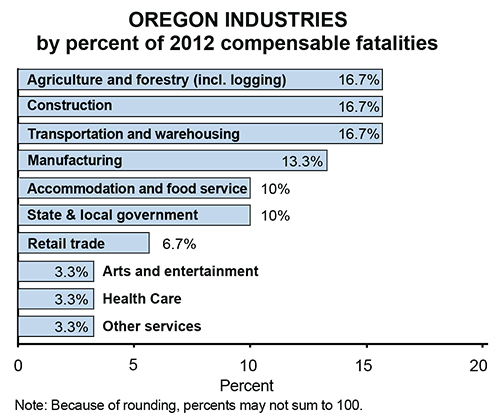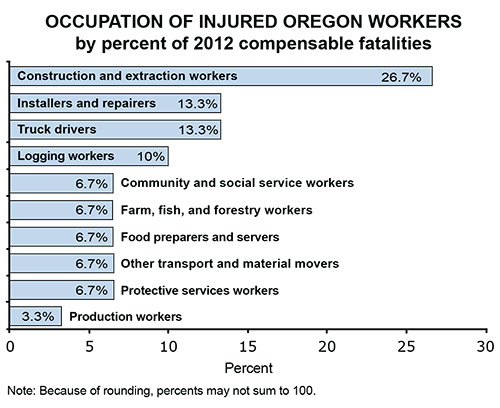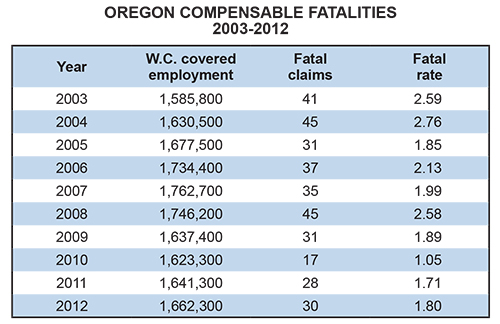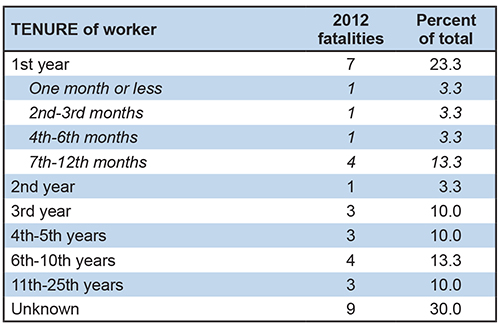
| Click here to see the printable version of this brochure | |
The Workers’ Compensation Division received notification of 30 compensable fatalities in 2012. This is 13 more than the record low of 17 in 2010, but it is still the third lowest ever reported since Oregon began tracking in 1943. |
Note: Employment figures are based on data from the Oregon Employment Department. Fatality rates are the number of accepted fatal claims per 100,000 workers. The 2012 employment and fatality rate estimates are preliminary. Data exclude deaths of workers not subject to Oregon workers’ compensation coverage, such as workers who were self-employed, who worked for out-of-state employers, city of Portland police and fire employees, and federal employees. |
 |
 |
Compensable Fatality Facts
|
At least two of the eight workers killed in highway accidents were not wearing seatbelts (three were unknown).
Trucks were the source for seven of the 12 vehicles involved in fatal accidents, four of which involved semi-trucks.
Note: Tenure is the amount of time the worker had worked for the employer at injury and is not necessarily indicative of the worker's level of experience. |
Oregon Occupational Safety and Health Division (Oregon OSHA)
The Oregon Occupational Safety and Health Division (Oregon OSHA) offers a wide range of services to Oregon's employers and workers to improve workplace safety and health. These services include:
- Consultations
- Education/conferences
- Technical resources and film library
- Educational grants
- Hazard abatement assistance
For more information, contact: Oregon OSHA, 350 Winter St. NE, Rm. 430, P.O. Box 14480, Salem, OR 97309-0405
503-378-3272 or 800-922-2689
www.orosha.org
Fatality/claims data
Visit the DCBS Web site at http://dcbs.oregon.gov. Select the “Statistical Reports” link for additional workers’ compensation claims data and other statistical reports, or call the Information Management Division at 503-378-8254.
Census of Fatal Occupational Injuries
National work-related fatality data can be found on the Bureau of Labor Statistics' Web site at: http://www.bls.gov/iif/oshcfoi1.htm
Fatality Assessment and Control Evaluation
Information about Oregon Health Sciences University's Fatality Assessment and Control Evaluation Program (FACE) can be found at: http://www.ohsu.edu/croet/face/
Employer workers' compensation coverage
For additional information about employer coverage requirements, you may contact the Workers' Compensation Division Employer Compliance Program at wcd.employerinfo@state.or.us,
call 888-877-5670, or find it on the Internet at: http://www.cbs.state.or.us/external/wcd/index.html
Classification systems
Data are classified according to the following classification systems:
- Occupational Injury and Illness Classification System (OIICS)
- Standard Occupation Classification System (SOC)
- North American Industry Classification System (NAICS)
Research Analyst, Information Technology and Research Section, Central Services Division. In compliance with the Americans with Disabilities Act (ADA), all CSD publications are available in alternative formats by calling 503-378-8254. The information in CSD publications is in the public domain and may be reprinted without permission.This document was originally published in October 2013.
Printed form 440-0947 (10/13/COM)



